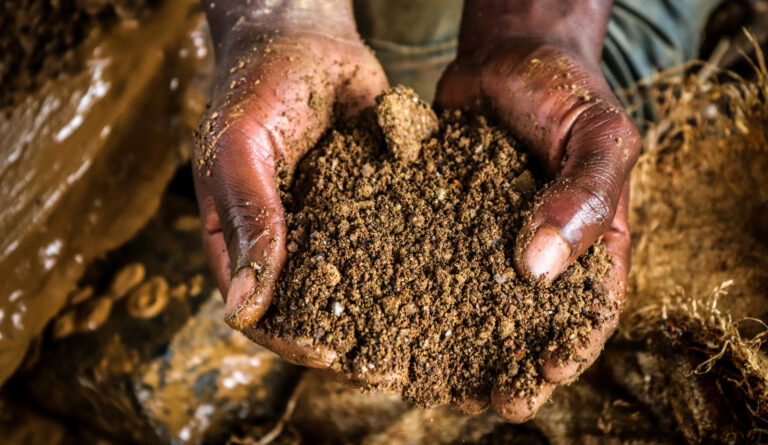
5G is described as the fastest of all communication systems. But its delicate, costly and energy-intensive deployment requires the use of more non-renewable and depleting natural resources.
Digital has embodied the idea of technological progress in our time and has promised exponential growth of “everything digital”. As we move towards the deployment of 5G, the more we doubt its impacts.
"To dare ; progress comes at a price “yes, but what?”
Victor Hugo
The rise of electronics in our societies has exploded the demand for metals in recent years. [1]Justice and Peace Commission, “Behind our screens: the challenges of mining”, Educational tool 2019.. Today we use three times more metals than 20 years ago [2]Behind our screens: op.cit.. Focus on the smartphone: the GSM produced in the 90s consisted of around 20 metals while today's smartphone contains more than 45 metals.
5G is intended to be the modern standard for millennial mobile telephony, which would like to complement or even replace current 4G. A technological advance in telecommunications which is intended to be revolutionary and more efficient than all the other processes we know today. It perhaps undoubtedly has its benefits?, but it also brings a new threat both for exhaustible minerals and the environment to be protected.
The deployment of 5G will certainly require the extractivism of its natural resources which are nevertheless not renewable? Furthermore, the use of rare metals that constitute its digital components? Non-renewable resources have a limited lifespan, since they are formed during geological processes which have often lasted millions or even billions of years; therefore, stocks decrease each time they are used and do not regenerate over the course of a human lifetime [3]Justice and Peace Commission, “limited resources, endless conflicts”, Study 2020..
The OECD estimated, based on the levels known in 1999, “that with an annual growth rate of their primary production of 2%, the reserves of copper, lead, nickel, silver, tin and zinc would not exceed 30 years, aluminum and iron being located between 60 and 80 years old ; the era of scarcity would therefore emerge for an increasing number of materials » [4]Opinion of the European Economic and Social Committee, for more sustainable consumption: the lifespan of industrial products and consumer information in the service of confidence... Continue reading. Despite the improvement of techniques, the concentration rate of rare metals, Coltan, cobalt, gold, tantalum, tin and tungsten, etc., necessary for the manufacture of the components of our digital objects is decreasing by more and more. Future operations, for their part, could be oriented towards the sea depths, requiring more energy. An ADEME study in 2017 suggested that by 2050 the demand for mineral resources would double; “Silver disappearing…, the world will have exhausted its reserves in 2029”, “The end of copper in 2050”.
Indeed, the internet, electric vehicles, robotization, connected objects... produce the opposite effect to that sought in terms of reduction of greenhouse gas emissions, dependence on fossil fuels and digital sobriety, in view of the proliferation of digital equipment, consumption of raw materials, production of waste.
The operation of several billion connected objects requires electricity to run the machines, which also depends on fossil fuels to produce energy and turn the turbines and thus contributes to the depletion of fossil resources; for example the oil to be extracted today requires more oil invested in extraction to extract an equivalent quantity than in the past [5]The Justice and Peace commission, behind our screens: the challenges of mining, an educational tool..
In a digital era and a hyper-connected world, it seems difficult for citizens to resist the consumerist call to always update themselves by using the latest releases of devices which nevertheless seem to offer more facilities, efficiency and yield. It should be noted, however, that the downside looks bleak for the environment. Digital technology is not intangible and its environmental impacts are very real. Digital represents 4.2 % of primary energy consumption and is currently responsible for 4% (including 25% due to data centers, 28% due to network infrastructures, 47% due to consumer equipment) of global gas emissions greenhouse effect and the sharp increase in uses suggests a doubling of this carbon by 2025 [6]ADEME, French Ministry of Ecological and Inclusive Transition.. These GHG emissions contribute to global warming and ocean acidification, etc. Pollution of water, soil and air near extraction and metal refining sites but also manufacturing plants is also responsible of a loss of biodiversity. It will be the same for the deployment of 5G if we take into account the astronomical quantities of materials necessary for the construction of these hundreds of millions of antennas necessary for how it works. The use phase also represents a significant part of the environmental impact of digital technology. Digital consumes 5.5% of global electricity [7]F. Borgade, op.cit., p.10.. Nearly 70% of the world's electricity used by data centers and electronic equipment is produced fromfossil fuels. Apart from the electricity consumption of a switched on device, the “ Datacenter » also have energy consumption through the operation of the servers; the servers operate constantly and offer different services such as: databases, electronic mail, access to World Wide Web (www) information, games and software. According to the International Energy Agency (IEA), the electricity demand of “ Datacenter » was estimated in 2018 at 198TWH (terawatt hour), or nearly 1% of global demand or the equivalent of the production of 28 nuclear reactors. Global warming requires us to change our habits at the risk of leading to imaginable consequences such as the melting of glaciers, rising sea levels, etc. [8]2017 study, A planet on its last legs, Justice and Peace Commission, P 16.. We will have to reduce our greenhouse gas emissions in order to hope to keep the temperature below 2°C by 2030.
The consumption of resources in industrialized countries, particularly mining, is increasing without taking into account the realities of producing countries.
- Case of the DRC and the Rush for Cobalt
Classified among the poorest countries on the planet, the Democratic Republic of Congo (DRC) is nevertheless full of wealth whose reasonable exploitation and equitable distribution would be sources of both economic and social development; hydraulic resources, gold, diamond, copper, Coltan, Uranium but also Cobalt; minerals essential to our new technologies. The DR Congo is the largest producer of copper in Africa, it holds half of the planet's reserves and alone provides more than half of the world's cobalt production (the DRC has 60 to 80% of Coltan and 50 to 60% of reserves of global cobalt) [9]Geological Survey, Mineral Commodity Summaries, January 2018.. - Violation of human rights
An essential component of the batteries of our smartphones, tablets, scooters and electric bikes and electric cars, cobalt comes largely from mines located in the south of the Democratic Republic of Congo (DRC), where a quarter of the cobalt exported comes from artisanal mines, in which miners – including children – use very rudimentary tools to dig and extract the precious metal[10]Amnesty International report “DRC: children in the hell of artisanal cobalt mines, intended for smartphones and electric cars”, African Resources Watch (Afrewatch) “Human … Continue reading. These artisanal miners work without any protection, exposing their skin and lungs to the highly irritating cobalt dust. Dug with bare hands, without adequate equipment and without precautions, the wells and galleries regularly collapse, burying the workers, for only 1 or 2 dollars per day. Emblematic and problematic figures in the DRC (child labor, deadly landslides, looting, etc.), the “diggers” are a minority but not marginal in the Congolese production of the cobalt raw material (14 to 16% of the 80,800 tonnes produced in 2017 according to the London broker Darton Commodities) [11]Global rush for Congolese cobalt: China, gold medal, L’Obs., February 21, 2018.. More than 40,000 children aged 3 to 17 work in mines in the south of the country according to Unicef and working conditions are not necessarily better in industrial mines managed by multinationals. - Risk of emergence and perpetuation of conflicts
Studies carried out by the UN show that more than 40% of internal armed conflicts over the last 60 years have been linked to natural resources [12]UN, statements by Mr. Antonio Guterres, Secretary-General of the UN, “root causes of conflicts-the role of natural resources” (S/2018/901).. Many studies and analyzes which have been the subject of research by the Justice and Peace Commission have shown that in DR Congo, armed conflicts are not unrelated to the country's mineral wealth. The situation of insecurity and violence which persists in eastern DRC, mainly due to the presence of around a hundred different armed groups in the region, is directly linked to the trade in natural resources. Furthermore, these “artisanal” mines are located in areas controlled by rebel groups and not by States. These minerals are therefore extracted in conflict or high-risk areas, mainly in the Democratic Republic of Congo (DRC), which contributes to the instability of the country. We should add cobalt, not officially classified as a conflict mineral but which is also extracted under catastrophic social and environmental conditions.
A determining technology for the economy of the future and for which propaganda is in full swing, the issues around 5G, personalized by the conflict around Huawei are presented as crucial, because it is the first place in the economy of the future, with its share of goods to be produced and consumed.
The importance of 5G for the European Commission is not new: it made a reminder in 2014 concerning the importance for the EU to develop the infrastructure to deploy 5G in 2020. The Commission's objective European is to have in each European country a city connected to 5G. The Brussels government has given its agreement for the deployment of this broadband technology in the Belgian capital. For their part, the Walloon and federal governments are implementing their digital plan: “Digital Wallonia” and “Digital “Belgium”, which constitutes an action plan which outlines the digital vision in the long term of Belgium. Political and media perspectives on 5G rarely tend to reject a technology presented as a solution to ecological problems. The Internet of Things, smart cities » and “autonomous cars” are generally presented as tools to respond to the “climate emergency”, when in reality these technologies generate extractivism and excessive pollution, as well as many other nuisances. The omnipresence of digital technology pushes us to question the society in which we operate and the models that we want to build for a truly fairer and more sustainable world for our future generations. Today, it seems difficult to do without digital technology, so it is important to ask ourselves “do we really need it”. Faced with this situation which sometimes suggests helplessness, there are several levels of action to act on the issue of 5G deployment. As citizens, it is possible to sign petitions that go against the deployment of 5G, to make citizen pleas to public decision-makers in order to influence judgments and engage in civil disobedience. and peaceful demonstrations. We should mobilize if we want to live in a healthy and sustainable environment.
Christine NOUGLI.
Attachments
Notes[+]
| ↑1 | Justice and Peace Commission, “Behind our screens: the challenges of mining”, Educational tool 2019. |
|---|---|
| ↑2 | Behind our screens: op.cit. |
| ↑3 | Justice and Peace Commission, “limited resources, endless conflicts”, Study 2020. |
| ↑4 | Opinion of the European Economic and Social Committee, for more sustainable consumption: the lifespan of industrial products and consumer information in the service of regained confidence, October 2013. |
| ↑5 | The Justice and Peace commission, behind our screens: the challenges of mining, an educational tool. |
| ↑6 | ADEME, French Ministry of Ecological and Inclusive Transition. |
| ↑7 | F. Borgade, op.cit., p.10. |
| ↑8 | 2017 study, A planet on its last legs, Justice and Peace Commission, P 16. |
| ↑9 | Geological Survey, Mineral Commodity Summaries, January 2018. |
| ↑10 | Amnesty International Report « DRC: children in the hell of artisanal cobalt mines, intended for smartphones and electric cars », African Resources Watch (Afrewatch) “Human rights abuses in the Democratic Republic of the Congo power the global trade in cobalt”, 2016. |
| ↑11 | Global rush for Congolese cobalt: China, gold medal, L’Obs., February 21, 2018. |
| ↑12 | UN, statements by Mr. Antonio Guterres, Secretary-General of the UN, “root causes of conflicts-the role of natural resources” (S/2018/901). |






